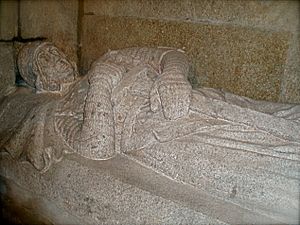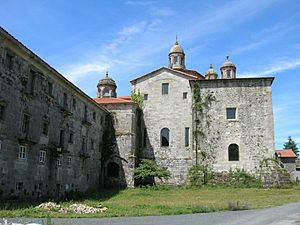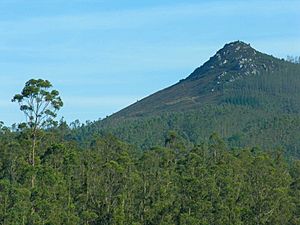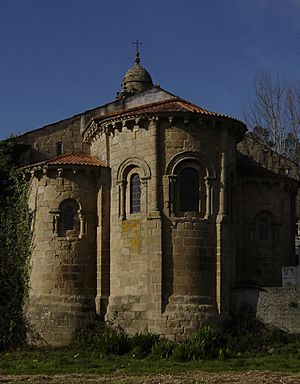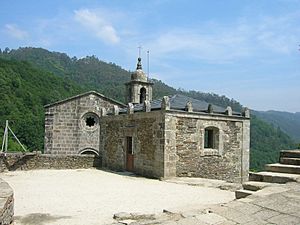Pedro Fróilaz de Traba facts for kids
Pedro Fróilaz de Traba was a very powerful noble in the Kingdom of Galicia (a region in Spain) during the early 1100s. People described him as "spirited," "warlike," and a man who "feared God." He grew up in the royal court of Alfonso VI of León, a powerful king. Later, Pedro himself raised the future King Alfonso VII in his own home.
Pedro and a bishop named Diego Gelmírez worked together to lead Galicia during the difficult reign of Queen Urraca (1109–1126). In September 1111, they even crowned the young Alfonso as king in Santiago de Compostela. Pedro was so powerful that he was called "emperor in the ambit of Galicia."
Pedro traveled a lot and had many important connections, especially through the marriages of his daughters. He had at least sixteen children with his two wives. Besides being a political and military leader, he was also very religious. Before 1109, he started the first religious house for women in Galicia. Pedro was very generous to the Cathedral of Saint James in Compostela, which is why he is one of the best-known Spanish nobles from his time.
Pedro's Family and Life
Pedro was the son of Froila Vermúdez de Traba and Elvira de Faro. We first hear about Pedro in 1086 when he signed a document for his father. The Historia compostelana, a history book from that time, says Pedro was raised in the court of King Alfonso VI.
Pedro had two wives. His first wife was Urraca Fróilaz, whom he married before 1088. By 1105, Pedro had married his second wife, Mayor Rodríguez. Mayor was very generous to churches, including Lugo Cathedral and the monasteries of Jubia and Sahagún. She was last mentioned alive in 1129.
With his first wife, Pedro had three sons and two daughters. His most important sons were Bermudo and Fernando. His other children included a son named Froila and daughters Jimena and Lupa. With his second wife, Pedro had six daughters—Elvira, Estefanía, Ilduara, Sancha, Toda, and Urraca—and five sons—Rodrigo, García, Martín, Sancho, and Velasco.
Pedro's Political Journey
Supporting Raymond of Galicia (1090–1107)
In 1090, Pedro was in charge of a place called Ferreira in Galicia. He was called "lord of Ferreira." Later, he became known as "Pedro Fróilaz de Traba." By 1096, Pedro had earned the title of "count," which was the highest noble title in the kingdoms of León and Castile. He also governed Traba, the place his family name came from.
Pedro was a strong supporter of Raymond of Galicia and his wife, Urraca. He probably knew them from his time at King Alfonso VI's court. In 1105, Raymond and Urraca's son, Alfonso Raimúndez, was born and placed in Pedro's care. It was common for noble children to be raised in other important households.
Forming a Powerful Group (1107–1109)
After Raymond died, his wife Urraca gave a monastery to the Archdiocese of Santiago de Compostela. Pedro Fróilaz and other important bishops and nobles were there to support this. In 1107, Pedro also signed a royal document as "Count Pedro of Galicia."
By 1109, Pedro's power in Galicia was so great that he began calling himself "Count of Galicia," even though he didn't control the whole region. This happened shortly after King Alfonso VI died and Urraca became queen. A document from 1121 described Pedro as a count "in the maritime province," meaning he controlled the Atlantic coastlands of Galicia, especially north of the Tambre river.
Fighting Alfonso the Battler (1110–1112)
In 1109, Queen Urraca married Alfonso the Battler, the King of Aragon. Pedro did not like this marriage because he worried it would affect the future of Urraca's son, Alfonso Raimúndez. Within months, Pedro rebelled against Urraca in Galicia.
In 1110, Alfonso the Battler entered Galicia with his army. Pedro met with Urraca and later with Henry, Count of Portugal, to discuss the situation. Pedro then arrested some of the queen's supporters and returned to Galicia. He negotiated with the queen, and she gave him the castle of Santa María de Castrelo on the border with Portugal. This castle helped him communicate with Henry.
Later in 1110, Pedro placed his wife, Mayor Rodríguez, and young Alfonso in his new castle. However, a nobleman loyal to the queen attacked, forcing Pedro to retreat. His wife and Alfonso were trapped in the castle. Pedro asked Bishop Diego Gelmírez to help, but after the siege was lifted, Urraca imprisoned Pedro, Diego, Alfonso, and Mayor. Pedro was released in January 1111.
On September 19, 1111, Diego and Pedro crowned the young Alfonso as king in Santiago de Compostela. After the crowning, Pedro and Diego gathered an army to take control of Galicia. They captured Lugo, which was loyal to Alfonso the Battler. However, they were later defeated by Alfonso the Battler in the Battle of Viadangos, and Pedro was captured. Diego escaped with young Alfonso and brought him to Queen Urraca.
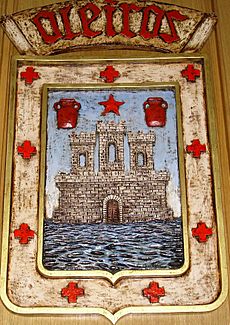
By May 1112, Pedro was released. Urraca was soon forced to recognize Alfonso as her heir and co-ruler. Young Alfonso was again placed in the care of Diego and Pedro. Around this time, Pedro was granted a royal castle at Oleiros in northern Galicia.
Protecting Alfonso Raimúndez (1112–1122)
From 1112 to 1122, Pedro was a tutor and protector for Alfonso Raimúndez. In 1112, Queen Urraca herself said that Pedro was the one "who raised and nourished my son the lord king Alfonso." As late as 1122, Alfonso still called Pedro his "royal protector." Around this time, Pedro made peace with an old enemy, Arias Pérez, by marrying his daughter Ildaria to him.
In 1114, Queen Urraca went to Galicia to try and reduce Bishop Diego's power. Pedro Fróilaz and other nobles joined her at first. However, Pedro changed his mind and decided to support Diego. After Diego successfully defended himself, the queen tried to kidnap him, but Pedro secretly warned the archbishop, who escaped.
Pedro and Alfonso Against Diego and Urraca (1116–1118)
In 1116, Pedro was fighting with Alfonso Raimúndez near Toledo for Queen Urraca. He learned of a plot by the queen to capture the archbishop and warned him again. Pedro and Alfonso quickly returned to Galicia and started a rebellion. Urraca marched into Galicia, gaining many supporters. Surprisingly, the people of Compostela fought for Urraca against their own leader, Bishop Diego, and his allies. The rebels had to leave the capital.
In May 1116, Urraca granted a document to Diego, which Pedro also signed, showing he was part of the alliance at first. But when Urraca was fighting another noble, Pedro and Countess Theresa of Portugal surprised and trapped her in Sobroso Castle. The queen had to retreat to Compostela and then to León. Pedro also had some disagreements with Bishop Diego during this time.
In the autumn of 1116, Urraca met with Alfonso's group, led by Diego and Pedro. Urraca gave her son Alfonso the Kingdom of Toledo to rule, which temporarily drew him away from Pedro and Diego.
In the spring of 1117, Urraca came to Santiago to settle a dispute between Bishop Diego and the townspeople. During a meeting, the townspeople revolted and forced Urraca and Diego to hide in a cathedral tower, which they set on fire. When the queen came out, she was attacked by the crowd. She and Diego then joined the army that Pedro Fróilaz and Alfonso had gathered. When Pedro's forces arrived, the town surrendered. Its leaders were sent away, and the archbishop's rule was restored.
Final Conflict with Urraca (1120–1123)
In 1118–19, Pedro Fróilaz was the most important noble supporting Alfonso Raimúndez's claim to the throne. In 1120, Urraca returned to Galicia and formed a temporary alliance with Diego against some of Pedro's supporters. However, Urraca later imprisoned Diego and tried to take control of his lands. Her son Alfonso then left her camp and joined Pedro near Santiago. This caused riots, and Urraca was forced to release Diego.
In 1121, Urraca took away Bishop Diego's secular lands and castles. This led to a dispute with the Pope. Urraca then gathered an army and invaded Galicia, camping near Santiago de Compostela. Archbishop Diego and Count Pedro raised an army and fought some small battles. Eventually, Diego arranged a peace.
Sometime after March 1123, Queen Urraca had Pedro arrested and imprisoned along with his sons. His lands were taken away. Pedro remained a prisoner until Urraca died. His sons continued to support Theresa of Portugal, an enemy of the queen.
Religious Support
Pedro was a big supporter of Benedictine monasticism and the Cluniac reform, which aimed to improve monasteries. He gave money and land to monasteries like Jubia, Nemeño, and Pedroso. In 1113, Pedro and his siblings gave the Jubia monastery to the Abbey of Cluny. He also gave land to the church of Cospindo near Traba to the archdiocese of Santiago de Compostela. He was so generous to the Cathedral of Santiago that the Historia compostelana said it couldn't list all his gifts. Pedro and his second wife wanted to be buried in the Cathedral of Santiago de Compostela.
The Historia compostelana says there were no nunneries (monasteries for women) in Galicia around 1100. Pedro Fróilaz changed this before 1108. He brought back the old monastery of Cines as a community for nuns. However, in 1108, a group of monks took over the monastery. Pedro then removed the monks and put the women back in charge. This caused a disagreement that even went to the Pope.
Pedro traveled all the way to Rome to explain his case to the Pope. He convinced the Pope that the monastery was his family's property. The Pope then ordered that the women be re-established at Cines.
Pedro's Death
Pedro was last mentioned in a document from March 25, 1126. On May 3, his widow made a donation to a monastery for his soul, which likely means he had died by then. The Historia compostelana says Pedro divided his properties among his children on his deathbed.
Pedro was known for traveling a lot and having many connections for a noble of his time. He grew up in the royal court, was held captive in Aragon for a while, and knew princes from southern France. He was buried in the Cathedral of Santiago de Compostela, where his tomb with a stone statue can still be seen in the "Chapel of Relics."
See also
 In Spanish: Pedro Froilaz para niños
In Spanish: Pedro Froilaz para niños


